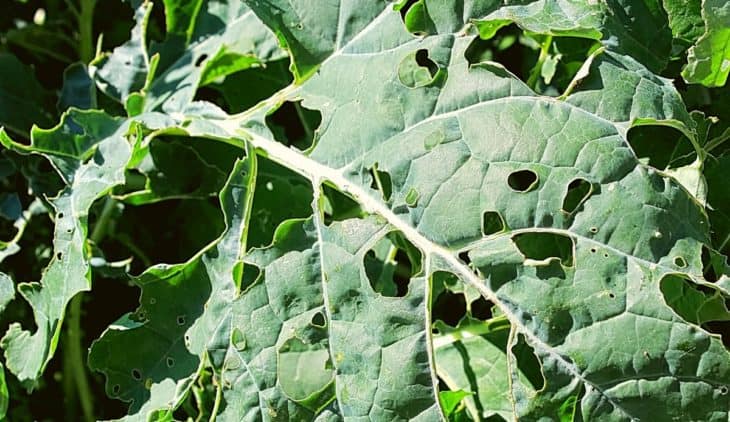Would you advise what is eating my broccoli leaves as I have noticed big holes on the leaves but cannot see what insect is eating them?
Broccoli is one of the most beautiful plants to grow. Every gardener experiences a good feeling when you head out to your garden in the morning and see big broccoli heads growing. It gets even better when these heads are ready for harvest, and you finally get to enjoy the fruits of your labor.
However, one thing can make you lose all this beauty. You might notice holes in broccoli leaves that are caused by an insect. But what kind of insect? Don’t worry about it; we will talk about the list of insects and how you can protect your broccoli from these devastating pests.
So What Is Eating My Broccoli Leaves?
If you notice something is eating your broccoli leaves or heads, please note that you have an insect problem.
Cabbage moths are one of the most common broccoli pests that make big holes in the leaves. There are also other insects like flea beetles, diamondback moths, etc., that feast on your broccoli leaves.

Common Pests Eating Your Broccoli Leaves
There are a few pests that love to munch on your broccoli leaves that we will look at. Not only do they eat broccoli leaves that they also eat other crops like cabbage, Brussel sprouts, etc. These veggies are best grown in raised beds or gardens, making them highly susceptible to certain pests.
The most common pests that love to eat your broccoli leaves include:
Flea Beetles
Flea beetles look like a cross between a flea and a small black beetle. Flea beetles are easy to identify because they leave behind many small holes on the broccoli leaves that look like they were caused by buckshot. They also jump like fleas making the traditional pick and squish method highly effective in destroying them.
You cannot control flea beetles. However, if left unchecked, they infest in large numbers on a young plant and can cause premature death of your plant. Severe damage from these beatles causes your plants to get stunted growth and cannot flower or fruit.
Prevention Methods
-
-
Clean your Garden after a Crop. Flea beetles can overwinter in the ground in the rotting plant debris. It is essential to clean your garden well when the growing season is over.
-
Use Sterilized
Soil . Plant your seeds or seedlings in sterilizedsoil for extra protection when growing your broccoli. -
Use Floating Row Covers. Try using floating row covers as a barrier to protect your young broccoli plants because they are more vulnerable.
-
Agribon AG-19 Floating Row Crop Cover
-
-
Use Trap Crops. Trap crops act as a sacrificial offering that flea beetles eat, preventing your actual crop from damage. To protect your broccoli leaves, you can use other plants like marigolds.
-
Use a Thick Mulch. Covering the ground with thick mulch prevents the flea beetles from reaching the surface.
-
Use Organic Insecticides. You can use neem oil or diatomaceous to prevent infestations. Other insecticides will also work but will need frequent reapplication.
-
Learn more about A Guide On Planting Carrots In The Fall
Cabbage Moths
Cabbage moths are a significant enemy of the broccoli plant. Have you seen giant white moths flying around the leaves of your broccoli? Maybe you love them because they look pretty, thinking they are some beneficial pollinators. In an actual sense, these are not moths, neither are they beneficial pollinators. They are butterflies fluttering around your broccoli and laying legs underneath the leaves, about 300 to 400 eggs, to be exact.
These eggs are tiny but will eventually hatch into green caterpillars that grow big and fat, courtesy of your nutritious broccoli leaves. These caterpillars feed ravenously on your broccoli plant’s inner and outer leaves, the actual florets, and broccoli head.
Preventing Cabbage Moths
-
- Use the Traditional Method of Hand-picking. The gruesome pick and squish technique is the conventional way of dealing with this insect infestation. Hand-pick all the caterpillars you can see and squish them or throw them in a bucket full of soapy water. This method is helpful if you only have a few plants.
-
-
Use an nsecticide. If you have a large garden, it will be better to use an insecticide. Choose an effective and organic insecticide that has naturally occurring bacteria effectively killing cabbage moth caterpillars.
-
Use Row Covers. If you don’t want to spend time squishing bugs or spraying insecticides, try using row covers. This method requires covering your rows, preventing them from moths flying over them and laying eggs. It requires the least effort and still works to keep off the caterpillars.
-
Check Out How Often Should I Flood My Ebb And Flow
Diamondback Moths
Freshly hatched diamondback moth larvae eat your broccoli leaf in both upper and lower parts. When the lover matures, it leaves large red holes with irregular edges on the lower sides of the leaf.
When young, the larvae can be green and turn brown once they mature. When disturbed, the mature larvae drop from the leaf on a silken line like a spider’s web.
Prevention
-
-
Apply organic insecticide. Use organic insecticide early morning or late afternoon to avoid the sun’s UV rays breaking down the bacteria.
-
Use parasitic stingless wasps. These will use the diamondback moth larva as a host; as a result, killing them. It’s a great way to prevent infestation without the use of an insecticide.
-

FAQs
How do I keep bugs off my broccoli?
If you are able to get your hands on a commercial product called "Stinger," which is a mixture of several insecticides and fungicides, it will most likely kill the insects.
In our area, we use a combination of neem oil and "Stinger" spray to keep the black flies from infesting our broccoli. We also put out water-filled milk jugs around the garden, which attract the adult black flies. We usually put one in each corner of the garden and they also help to control the number of aphids on the broccoli plants.
How do you protect broccoli?
When it comes to protecting your broccoli, there are two main types of protection: physical and biological. These two types of protection are used to control a wide variety of pests and diseases. Physical protection involves things like sprays, netting, and traps. Biological control involves using natural predators and parasites to control pest populations. So, the best way to protect your broccoli is to use both types of protection. The main problem with broccoli is that it’s a biennial plant. This means it has to flower and set seed before it can produce more broccoli. In other words, broccoli has to go through two growing seasons before it produces broccoli.
Broccoli is very susceptible to cold weather. I would recommend that you try and protect it by tying it up in a large, clean garbage bag.
What do you spray on broccoli plants?
Broccoli is very sensitive to insects. The best way to keep it bug free is to cover the plants with a floating row cover as soon as they are planted. Once they are about 6 inches tall, pull off the cover and plant in a permanent location. You can also use neem oil (also known as "oil of lemon" or "oil of citronella") as a general pest deterrent.
What is eating my broccoli heads?
The broccoli can be eaten by birds. Birds will eat the stems of plants to help them get their own food. They will also eat the flowers of plants. If the broccoli heads are growing in a vegetable garden where there is competition for nutrients from other plants, you may be seeing what looks like the birds have been eating your broccoli. You may want to look for a bird feeder that is specifically made for the area you live in, so that you can prevent your bird problems from getting worse. Broccoli is also susceptible to pests and diseases. It can be attacked by aphids, which are tiny insects that suck the juice out of the plant’s leaves.
They are often found on the underside of the leaves. They can cause damage to broccoli leaves, stems and buds, and they can make the plants appear sick. There is a natural pesticide that can be sprayed on broccoli plants that is safe for the environment, but you would need to apply it yourself. You can also use insecticidal soap. Broccoli is susceptible to fungal diseases as well, such as downy mildew. Downy mildew starts as a white or grey mold, and it will spread quickly through the leaves. You can treat the problem with fungicides, but you need to be careful not to kill your plants, as they are good for you. The best thing you can do is take care of your plants by watering them, making sure that they get enough light, and keeping the soil around them free of weeds and other competing plants.
Conclusion
I could tell something was eating my broccoli leaves, and with the above information, I now know what is eating them and how to protect my plants.
If you are growing broccoli, make it a habit to keep an eye on their leaves early to get rid of these pests immediately they strike quickly. The earlier you notice them, the easier it becomes to eliminate them before they destroy most of your crop.
Broccoli carries a ton of nutritional benefits with plenty of fiber, plus potassium and even some protein. It is an excellent source of Vitamin K and Calcium, two vital nutrients for maintaining strong, healthy bones. It also contains a good amount of phosphorus, zinc, and Vitamins A and C necessary for healthy bones as well.
Learn more about When To Harvest Broccoli Rabe

Brian is an avid gardener who loves spending time outdoors. He is passionate about using his green thumb to create beautiful, lush gardens for her friends and family. He finds joy in tending to her garden, trimming plants, and cultivating new species. He enjoys to share his knowledge and experience with others with a similar gardening enthusiasm. Brian is a true nature enthusiast and a has true passion for the outdoors.





